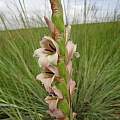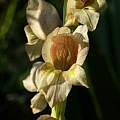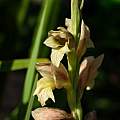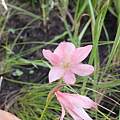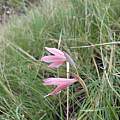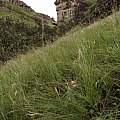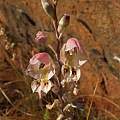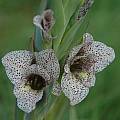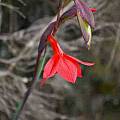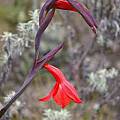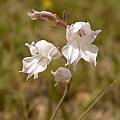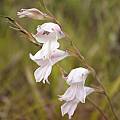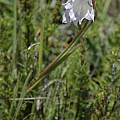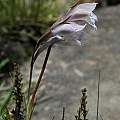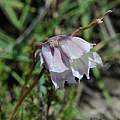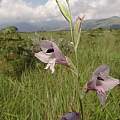Summer rain Gladiolus are mostly from the eastern part of South Africa. They generally like their summers wet and their winters dry, but just exactly how wet and how dry may vary widely depending on on the exact location of origin. Among the summer rain species are some of the most frost hardy of the African species, but as most tropical African Gladiolus follow a summer rain pattern as well, some are quite frost tender.
Page 1: G. albens... Page 2: G. densiflorus... Page 3: G. inandensis... Page 4: G. mortonius... Page 5: G. rehmannii...
Gladiolus sericeovillosus (Hook) is a medium sized summer flowering Gladiolus related to Gladiolus oppositiflorus with pale cream spotted flowers on a distichous spike from Transvaal grasslands. It comes in two subspecies. Photo from Rod Saunders.
G. sericeovillosus subsp. calvatus (Baker) Goldblatt is characterized by leaves which exceed the flower spike. This species may be found in trade as Gladiolus elliotii, likely because it was described by Lewis under this name, while the accepted Gladiolus elliotii (Baker) is a different species. Pictures by Martin Bohnet show a plant with exactly this misnamed history. He grows it in a container in southern Germany, even though some sources attest it hardiness to USDA Zone 7. The yellow throat markings are optional according to some descriptions.
G. sericeovillosus subsp. sericeovillosus has shorter leaves and fine hair on the bracts and stem. In some specimen, the spots on the flowers may be missing.
Gladiolus symonsii F.Bolus is a montane species growing at 1900 to 3200 m on grassy slopes and cliffs in the Drakensberg range of KwaZulu-Natal and eastern Lesotho. Plants are 25-45 cm high and flower in early to midsummer, December and January. Flowers are bright pink to pale rose, whitish in the throat and relatively small with a short tube. Stems are unbranched and the spikes bear only two to four flowers. There are three leaves with the lowermost longest, sheathing the lower third of the stem. This species has rarely been collected and three plants were discovered by the photographers Rod Saunders and Rachel Saunders in an area that had burned on a dark day with a storm coming making it difficult to get good photographs.
Gladiolus vernus Obermeyer grows in rocky grassland in the Blyde River Canyon area in Mpumalanga. It flowers in July and August in completely dry conditions before the first rain starts. Foliage leaves are produced afterwards in September or October. Flowers are pale to deep pink, or cream, with the upper tepals darker above and with a yellow zone on one or all of the three lower tepals. This zone is sometimes edged with dark pink or purple. The lower halves of the lower tepals are speckled with pink. Flowers are unscented and plants grow from 45 to 75 cm high. Photo from Rachel Saunders.
Gladiolus vinosomaculatus grows in exposed and often dry sites (rocky hilltops and slopes in short grassland) and on rocky outcrops in the summer rainfall areas of southern Africa north of the Vaal River. The tepals are covered with large purple to reddish spots on a pale background. The leaves have long sheaths that form a short pseudostem. This species is closely related to Gladiolus ecklonii. Photo taken by Rod Saunders.
Gladiolus watsonioides is found on the mountains of Kenya and northern Tanzania, growing from 2600 m to 3900 m. It is not quite a true alpine, but not far off. There is a frost almost every night and the plant copes with this well at all stages of its growth. With the almost constant daylength and general conditions through the year the plant can remain active without going dormant. This evergreen habit is maintained in cultivation & the plants remain green throughout the year if kept moist, but they can go dormant if they dry out. I have stocks from both mountains (Kilimanjaro and Mt. Kenya) and they grow equally well in a gritty, humus-rich compost in deep pots in a frost-free greenhouse, but there is no doubt that the Mt Kenya version is the one to grow. Description and photos by John Grimshaw. The last two images are of the Mt. Kenya version.
Gladiolus wilsonii grows in the Eastern Cape which is a summer rainfall area, but is a winter growing species that is listed as flowering from October to November. It grows in open grassland in light loamy sand. It has short tubed white to cream fragrant flowers. Sometimes the reverse of the upper tepals is flushed pink to purple toward the tips and sometimes the lower three tepals have a short pale mauve streak near the base. The first two photos by Cameron McMaster. The last three photos were taken January 2010 for this species near Maclear in the Eastern Cape by Bob Rutemoeller and Mary Sue Ittner. Originally identified as Gladiolus inandensis which is very similar, it has now been identified as this species since the other species flowers July into August.
Gladiolus woodii Baker grows in grassland, on rocky hillsides from 800 to 2000 m. in the summer rainfall area of South Africa from KwaZulu-Natal to the Limpopo Province. Mostly found in high elevation and high rainfall areas, it flowers early in the season, soon after it rains (from September to December). Leaves are often short and sheath the stem. Flowers are variable in color, pale yellow or lilac, oyster colored, dark maroon or red-brown with or without a longitudinal dark brown to purple stripe along the midline of the lower tepals and faintly to not scented. The upper tepals are much larger than the lower tepals and the lower laterals are folded. Photo from Rod Saunders.
Page 1: G. albens... Page 2: G. densiflorus... Page 3: G. inandensis... Page 4: G. mortonius... Page 5: G. rehmannii...
